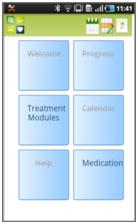Home
Welcome to the website of the ICT4Depression project, funded within the 7th framework of the European Union. Within this project, an innovative mobile solution for the treatment of depression has been developed, called Moodbuster (NL) / (SE). Several studies with the system have been performed. An adapted version of Moodbuster is currently (autumn 2013) being used in a follow-up study in a blended care care setting.
Moodbuster

Main menu of app
Monitoring
Monitoring behavior and emotions is an important component within the treatment of depression. This information is also used to give the participants adequate and personal feedback from the reasoning system. In Moodbuster information is gathered via ecological momentary assessments (EMA). The mobile phone is used to prompt the patient for a self-assessment of his mood and feelings, using an intuitive (graphical) interface. Participants will receive daily at random a request to rate their mood on their mobile phone. The minimum amount of required mood ratings is five. In addition, participants are asked to rate their sleep quality and anxiety once a day.
A second aspect of behavior that is monitored concerns biomedical information. Wearable bio-sensors have been developed that measure several reactions of the body to emotional changes, such as electro-dermal activity, respiration, electrocardiography changes.
Medicine intake is the third aspect that is being monitored. Participants who take medication for their depression use an electronic medicine monitoring system. This device is able to detect medicine intake and registers this without manual intervention.
Intelligent feedback
Another unique aspect of the Moodbuster system is that it interprets the data obtained from the monitoring system. The reasoning modules translates sensor information and information provided by patient into therapy information, and uses this to reason about the progress of therapy. In addition, it is used to deduce what therapy is most likely to be successful given the current state of the patient.
The reasoning system provides feedback to the depressed patient, e.g. by giving information on progress of the therapy, appropriate therapy models given the state of the patient, motivations and warnings, e.g. concerning compliance with drug descriptions. Patients receive this personalized automated feedback weekly on the basis of their answers to the prompt questions, home work made and bio-sensors. This is partly done via the cell phone, and partly via a personal website. Simple reminders and motivational messages are best suited for communication via the mobile phone, while the website is more appropriate for detailed progress feedback (e.g. an graphical overview of mood-ratings in the last month).
Partners
The project is carried out by an interdisciplinary consortium with 5 (research) organisations and 2 SME companies at the forefront of Artificial and Ambient Intelligence, wireless biosignal sensors, activity monitoring using cell phones, monitoring patient compliance with drug prescriptions, service oriented application for the health care domain, psychology, psychiatry, and internet-based psychological treatment.




